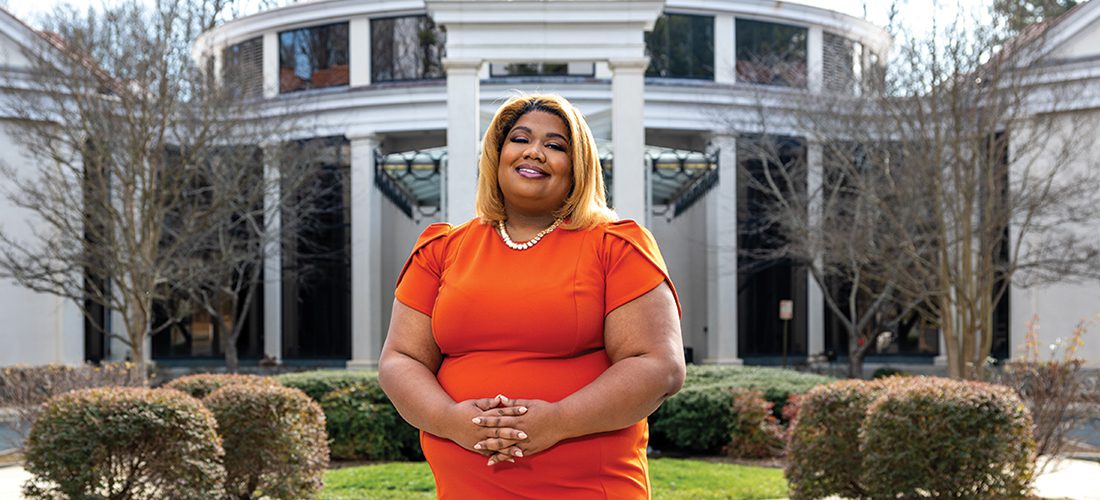History anew
March 1, 2023

Terri White, Charlotte Museum of History’s new CEO, aims to reshape community views of the east Charlotte institution.
by Michael J. Solender
Terri White believes a lifelong sense of curiosity will serve her well as the recently installed president and CEO of the Charlotte Museum of History.
“People are drawn to museums to enter new worlds and discover the unfamiliar,” says White, who joined the museum last summer. “Museums allow people to learn and expand their understanding of the world around them. As a Black woman who grew up in the inner city of a Rust Belt town in the late ’80s, had I only looked at my immediate environment, I would have seen economic depression and limited opportunity.” White says her curiosity led her to the library and museums, exposing her to worlds beyond her purview. “Here at the CMOH, I’m looking to expand the window into Charlotte’s history and open new doors of discovery for the entire community.”
White, 39, comes to the museum after serving in development and operations roles at both the Heinz History Center and the Carnegie Science Center in Pittsburgh, Pa., and at the Smithsonian’s National Air and Space Museum in Washington, D.C. She arrived in Charlotte in 2019 after landing an operations position at Lowe’s.
She assumed the helm at the museum with a full-time staff of six, an annual operating budget of $800,000 and the legacy of a quiet history institution best known as the custodian for the late 18th century-era Hezekiah Alexander House. The 1774 home, the oldest in Mecklenburg County, is listed on the National Register of Historic Places. Known affectionately as the “Alexander Rock House,” it is the museum’s most identifiable asset and while remarkable and prized, the house presents challenges to expanding the identity and mission of the museum.
Beyond the Rock House
“There is a limited impression of the CMOH in much of the community,” White says. “Many think of us as simply the ‘Rock House.’ They came here on their third-grade field trip, and that is their lasting impression of the museum. And while the period surrounding the house is important, we’re not the Charlotte Colonial Museum of History. It’s our mission to tell so much more of the events and circumstances that have shaped our region.”
A key focus in reshaping the museum’s narrative is diversity and inclusion. History is always framed by its tellers, and the recent strategic plan developed by the museum’s board of directors calls for the staff and programming to more fully represent the diverse makeup of the Charlotte community.
Dee Dixon, president and CEO of Pride Communications, is immediate past board chair at the museum and was the first Black woman in its history to hold that position. “I’m excited about bringing greater diversity to our staff, board and in our programming to allow for more comprehensive backstories on what gives our region its unique sense of place,” Dixon says. “Terri’s experience, operational skills and talents bring a dynamic energy to the museum. We’re very pleased to expand the understanding of Charlotte’s cultural fabric.”
Several initiatives are underway to extend CMOH’s reach into the community. None will make a greater impact than the relocation and restoration of the Siloam schoolhouse, a historic 1920s Rosenwald-era, one-teacher classroom building that once served Black children in then-segregated Mecklenburg County. Currently resting in disrepair at its original site in University City, the building will be moved to the museum’s 8-acre campus later this spring. The renovation will take 18-24 months. A recent $500,000 grant from Charlotte’s Gambrell Foundation brings the project’s fundraising total to $1.2 million, exceeding its original $1 million goal.
“Once the Siloam School is moved to the museum’s campus and restored, it will become a very visible and tangible part of our mission to save and share Charlotte’s history in all its fullness and diversity,” White says. Exhibits about the Black experience and community and educational programs are in development for the schoolhouse upon opening.
More recent history is also slated for exploration. Later this year, CMOH will showcase a mural on canvas depicting the Mecklenburg Declaration of Independence, painted by noted American muralist Eugene Montgomery. Originally commissioned in 1949 by retailer Sears, Roebuck & Co. for its uptown location (now home to the VAPA Center), the artwork measuring 73 feet by 6 feet has hung in the library at South Mecklenburg High School for the last five decades. Only a handful of the murals Montgomery painted still exist. The museum will exhibit the mural briefly this fall ahead of its restoration.
White is excited about the museum’s forthcoming exhibit showcasing the National Negro Opera Company. The company, founded in 1941 by Madison, N.C., native Mary Caldwell Dawson, was the first commercially successful Black opera company in America.
“Our exhibit, which features original opera company costumes on loan from the Heinz History Center, opens in January 2024,” White says. “It will remind people that this organization, with its under-told influence on American music, was founded by a Black woman from rural North Carolina.” Opera Carolina is partnering with the museum and is working with the renowned soprano Denyce Graves and her foundation to bring the original musical highlighting NNOC to Charlotte.
Continuing its focus on inclusivity and expanding its community reach, the museum plans to partner with local nonprofit Comite de Fiestas Patrias y Tradiciones de Charlotte and Norsan Media to celebrate various independence days for countries with significant Latin American populations in Charlotte. Hosting events on-site will expose new generations of visitors to the museum, White says. “In addition to the cultural celebrations, we are working on Spanish-language oral histories, artifact collection, and have a volunteer group to offer Spanish translations for our exhibits.”
To engage with Charlotte’s Asian community, as an initial step the museum will screen two documentary films chronicling life for Asians in the American South later this year.
The history and cultural impact of sports is a favorite topic for White. She’s already made inroads with Charlotte professional sports teams and expects soon to announce collaborative projects.
In the interim, she’s staying curious and continually asking the question of how Charlotte has become the city it is today. The answers are the stories she wants the museum to tell.
“If people thought they knew what the CMOH was about, they don’t,” White says. “Come look at what we are doing. There’s a world of discovery here.” SP
Featured photograph by Joshua Komer. Courtesy Charlotte Museum of History




